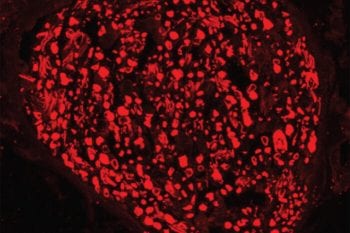Li, H., Russo, A., *DiAntonio, A. J Cell Biology, Volume 218: 4017-4029, 2019.
Tag: DiAntonio
Aaron DiAntonio receives Javits Neuroscience Investigator Award from NINDS

Aaron DiAntonio (Department of Developmental Biology) received a Javits Neuroscience Investigator Award (R37) from the NINDS. Recipients must be nominated by NINDS staff and demonstrate significant, paradigm-shifting contributions to the NINDS mission. The award converts a standard R01 into a 7-year grant. Congratulations, Aaron!
DLK Activation Synergizes with Mitochondrial Dysfunction to Downregulate Axon Survival Factors and Promote SARM1-Dependent Axon Degeneration (Links to an external site)
Summers, D.W., Frey, E., Walker, L.J., *Milbrandt, J., *DiAntonio, A. Molecular Neurobiology, Volume 57, Issue 2, 1 February 2020, Pages 1146-1158, 2019.
Vincristine and bortezomib use distinct upstream mechanisms to activate a common SARM1-dependent axon degeneration program (Links to an external site)
Geisler, S., Doan, R.A., Cheng, G.C., (…), *Milbrandt, J., *DiAntonio, A. JCI Insight, 4(17), art. no. e129920, 2019.
TIR domains of plant immune receptors are NAD+-cleaving enzymes that promote cell death (Links to an external site)
Wan, L., Essuman, K., Anderson, R.G., (…), *DiAntonio, A., *Milbrandt, J., Dangl, J.L., Nishimura, M.T. Science, 365(6455), pp. 799-803.
Wnd/DLK Is a Critical Target of FMRP Responsible for Neurodevelopmental and Behavior Defects in the Drosophila Model of Fragile X Syndrome (Links to an external site)
Russo, A., DiAntonio, A. Cell Rep Volume 28, Issue 10, 3 September 2019, Pages 2581-2593.e5, 2019.
Axon degeneration: mechanistic insights lead to therapeutic opportunities for the prevention and treatment of peripheral neuropathy (Links to an external site)
*DiAntonio, A, Pain, 160, pp. S17-S22, 2019.
DLK regulates a distinctive transcriptional regeneration program after peripheral nerve injury (Links to an external site)
Shin, J.E., Ha, H., Kim, Y.K., Cho, Y., DiAntonio, A., Neurobiology of Disease, 127, pp. 178-192, 2019.
Gene therapy targeting SARM1 blocks pathological axon degeneration in mice (Links to an external site)
*Geisler, S., Huang, S.X., Strickland, A., (…), *DiAntonio, A., *Milbrandt, J. J Exp Med, 216(2), pp. 294-303, 2019.
DiAntonio Lab publication (Links to an external site)
Russo, A., Goel, P., Brace, E.J., (…), Dickman, D., DiAntonio, A. The E3 ligase Highwire promotes synaptic transmission by targeting the NAD-synthesizing enzyme dNmnat. EMBO Rep, art. e46975, 2019.
Gene therapy study has implications for nerve degeneration (Links to an external site)

Aaron DiAntonio and Jeff Milbrant recently demonstrated the power of blocking the SARM1 pathway for preventing nerve degeneration. Building on previous work, they used adeno-associated virus to deliver a dominant-negative form of the SARM1 protein to mice. When axons in these mice were injured, they were resistant to degeneration. These studies have implications for many […]
DiAntonio/Milbrandt Lab Publication featuring Needleman Fellow (Links to an external site)
Karney-Grobe S, Russo A, Frey E, Milbrandt J, and DiAntonio A. HSP90 is a chaperone for DLK and is required for axon injury signaling. PNAS, 2018.